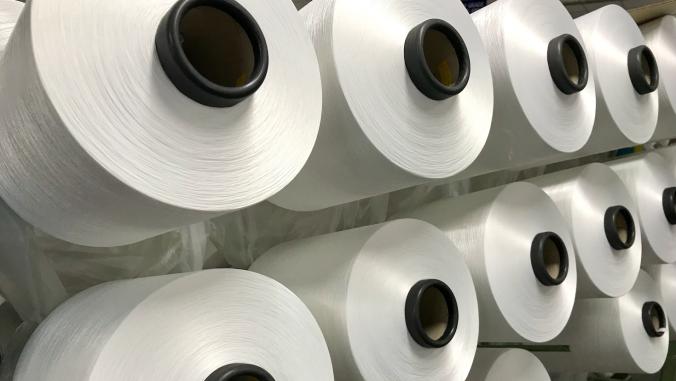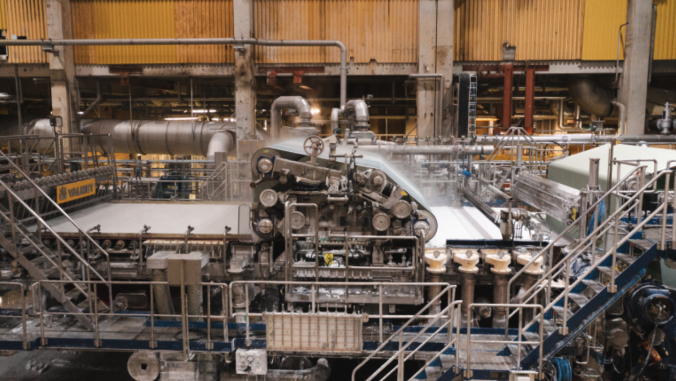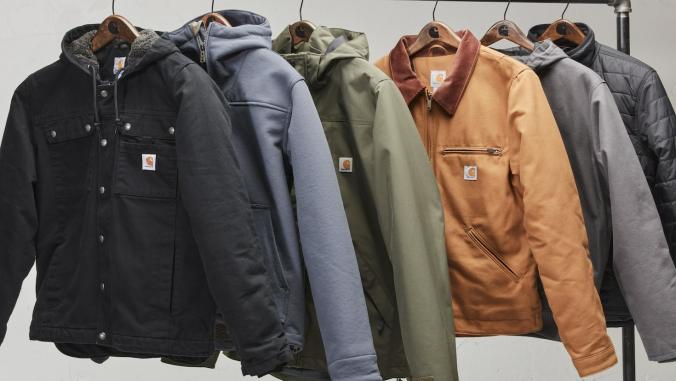What 'the kids' need from the professional world on climate action
Five lessons from young activists at VERGE 19.

From left: Marlow Baines, Global Crew Director for Earth Guardians; Isha Clarke, Youth Organizer for Youth Vs. Apocalypse; Tokata Iron Eyes, Indigenous Youth Leader and Advocate from the Standing Rock Sioux Tribe and Indigenized Energy; and GreenBiz Group's executive editor, Joel Makower.
Part of the power that young activists such as Greta Thurnberg hold for older folks is that they represent the fuzzy concept of "the future" in the flesh: Here, face your non-theoretical neighbors, nieces or grandchildren. Their complaints about inheriting a mess are legitimate. Plus, they appear to have more wisdom and stamina than you, and they probably don't even drink coffee yet. It's humbling.
And they're mobilizing at impressive levels. The Global Climate Strikes saw 4 million people taking to the streets in September, possibly a record for demonstrations over climate change.
These "kids" are not just pointing fingers and raging, but calling for action from all generations. There's reason for hope, given that youth-led movements historically have shown long-term tenacity against "even the toughest barriers, not the least of which can be the intransigence, negligence or timidity of their elders," GreenBiz Executive Editor Joel Makower noted back in the spring.
The consistent delivery of 16-year-old Thurnberg's "challenge-choice-opportunity" message about climate change is helping it to stick, Cara Pike wrote after joining her children at Vancouver-area protests last month. The founder of the nonprofit Climate Access added that "it also works because kids can create their own version of the story that reflects their context and experience."
Three teen activists drew on their varied backgrounds Thursday at GreenBiz Group's VERGE 19 event in calling for business leaders and innovators there to take the climate-crisis fight further, faster. Here are five takeaways:
1. Take us seriously
If climate activism is going mainstream, there's ample reason for companies to heed their future Generation Z employees and consumers, who are bracing for severe climate impacts well into adulthood. Policymakers, too, would be wise to listen their next-generation constituents instead of falling into the "adultsplaining" trap as California Sen. Dianne Feinstein did in an interaction caught on camera back in February.
Brower Youth Award winner Isha Clarke, 16, appeared with a group of young people in a viral video asking Feinstein to support the Green New Deal. "We have come to a point where our earth is dying, literally, and it is going to be a pricey and ambitious plan that is needed to deal with the magnitude of that issue, because that is the only thing that is —" the high schooler began.
But Feinstein interrupted: "That resolution will not pass the Senate, and you can take that back to whomever sent you here."This fight in the climate crisis is about completely reimagining the way that we exist in this world.
Clarke said she was used to adults condescending to her, and didn't realize the moment's significance until the video went viral.
"The most important part of the interaction was the public reaction," she said, noting that it helped to attract public attention and sway public opinion to the Green New Deal.
Meanwhile, Clarke, of Oakland, California, already had been part of a 2,000-strong demonstration for climate action during the spring — yet by September, that crowd had grown to 30,000 participants.
"All of us have a part to play in this," Marlow Baines, of Boulder, Colorado, said of the rising climate movement. The 17-year-old is global crew director of Earth Guardians, the organizational plaintiff in the Juliana vs. United States lawsuit filed in 2015. Its 21 young plaintiffs allege that the nation has violated their rights to life and liberty by advancing policies that contribute to global warming.
The lawsuit itself may not ultimately win in forcing the U.S. government to come up with a federal plan to slash emissions, but it is pushing some of the public to consider that the youth are serious enough to fight for the matter in court.
2. Focus on the systems
Many young climate activists are calling for radical change that would rewrite predominant social, economic and political systems. The speakers at VERGE blamed racism, greed and economic exploitation.
"This fight in the climate crisis is about completely reimagining the way that we exist in this world," Clarke said.
Tokata Iron Eyes, 16, hosted Thurnberg earlier this month at her high school at the Pine Ridge Reservation in South Dakota. At VERGE, the indigenous activist said it's critical to rethink priorities, such as valuing the right of people to a livable planet over economic growth. And a more holistic view of natural systems is critical.
"We can talk about lowering carbon emissions all we want but if we're not prioritizing people, if we're not prioritizing their problems and their lifestyles, then we’re not creating sustainable solutions," she said.
3. Include 'frontline communities'
At age 9, Iron Eyes began to speak against uranium mining in the Black Hills of South Dakota, advocating for sacred sites and indigenous rights. By age 12, the Standing Rock Sioux tribe member became one of the faces of resistance during two years of protests against the Dakota Access Pipeline.
"I could really feel and see the effects the pipeline could have," she said, noting that it would only take 10 minutes for her school's water supply to be polluted if a pipeline beneath her tribe's water source broke. "I found that I wanted to talk to regular everyday people who weren’t aware of the situation that indigenous people are in, that we’re in."Ultimately, this is a fight for our lives and this is a fight that needs to be led by people who look like me.
And indigenous people have an outsize ecological impact; they make up 5 percent of the global population but defend 80 percent of the planet's biodiversity. "If we’re not talking about protecting their ways of life, if we’re not talking about protecting their rights, we are not talking about solutions," she said.
The pipeline ultimately was installed in 2017 after the Trump administration pushed for it.
Iron Eyes described the devastation of living with the threat of the pipeline, fearing that "I might not be able to bring my kids back to their homelands, that I might not be able to ever drink from that river, take my family swimming."
Fifteen-hundred miles away, Clarke lives across the street from a freeway's fumes. She began demonstrating against a proposed coal terminal that was planned a couple of miles from her house. But she didn't get involved until she learned about environmental racism.
"At that moment I recognized how important my voice was in the movement, and I recognized that historically climate justice movements don't reflect me or the communities who are being directly targed by its impacts," she said.
Plans for the Oakland coal plant are on hold, at least for now.
Clarke, a member of the Youth Vs. Apocalypse activist group, urged the audience to look around in their workplaces to make sure that people beyond the majority populations are legitimately included and engaged, so that mistakes of the past don't continue to repeat.
4. Change mindsets
It's one thing for existing climate movements to embrace the privileged and underserved alike. But what will it take to win over those who remain unconvinced of the reality of climate change?
Baines said it's unnecessary to win over every last skeptic, but mainstream buy-in is enough to shift things collectively.
And education is critical. Clarke noted that in talking before high-school and middle-school classrooms, she finds that students who haven't been given adequate facts tend to trivialize the issues down to rainforests or polar bears.
"That’s a piece of it," she said. "But ultimately, this is a fight for our lives and this is a fight that needs to be led by people who look like me. ... It’s about telling the truth. That's how you get people involved."If we’re not talking about protecting their ways of life, if we’re not talking about protecting their rights, we are not talking about solutions.
Iron Eyes advocated for promoting a sense of urgency and finding common ground, such as the human need for clean water and air.
"At a base level, we're all the same," she said, and arguing with someone who believes that "eco-terrorists" have made up the climate crisis won't help. "So before we start talking about these political barriers that are keeping us apart, before we start arguing about these minute, almost imaginary things, let's talk about the things that move us, let's talk about the things that motivate us, and how we can protect those things together."
5. Help us
The young women called for the professional audience to lend their expertise and time toward their cause.
"We need people who know how to fundraise," Clarke said. "We need people who know how to make flyers. We need people who know how to go into school and talk. We need teachers. We need businesswomen and men. We need so many so many different types of people with different skills to bring into the movement.”
Baines echoed the sentiment, calling for mentors including entrepreneurs and speechwriters. "If y’all have resources or have 30 years of business experience, then that’s what we need," she said. "That is where we will begin to create this regenerative cycle because then you're also rising up with the youth."





